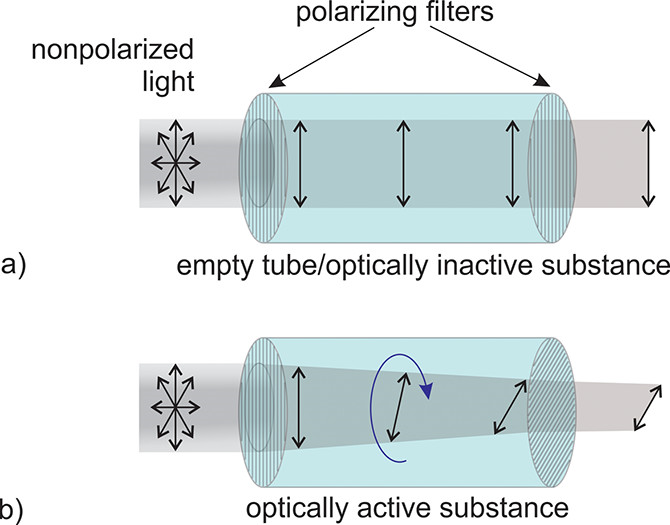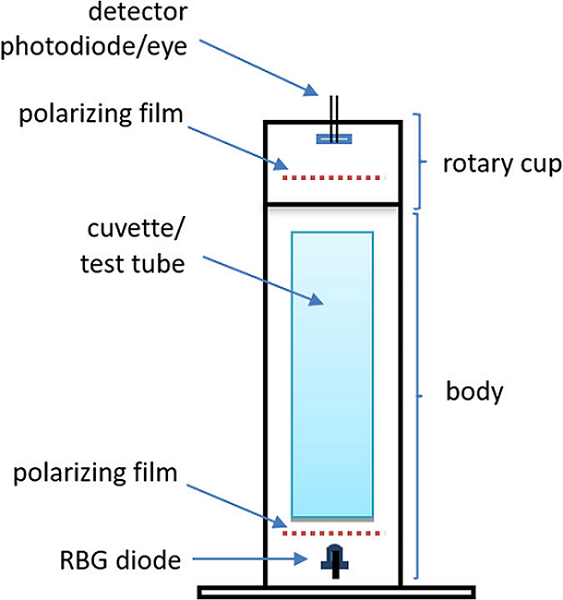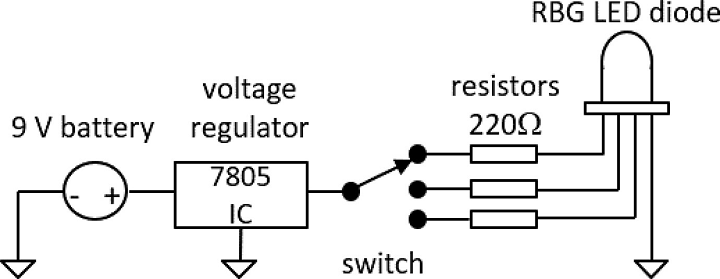The adoption of 3D printing in the classroom has opened up new horizons for creating teaching tools. Science teachers, in particular, can make personalized models of nanostructures, and educational tools like colorimeters. But there haven’t been any 3D printable designs for polarimeters, which measures the angle of rotation of polarized light once it’s passed through an optically active solution or substance. Paweł Bernard from Jagiellonian University and James D. Mendez from Indiana University – Purdue University Columbus published a paper about their creation of a low-cost 3D printed polarimeter.
“3D printing and simple electronics were used to create a polarimeter suitable for a variety of chemistry courses,” they wrote. “This device allows instructors to demonstrate optical activity but is also easy to use and low cost enough to be widely available for student use, as well. The instrument uses an LED light source and detector housed in a 3D-printed base. By rotating the top piece, users can visually detect changes in brightness or measure this directly with a multimeter.”
A polarimeter consists of a sample chamber, monochromatic light, and a polarizing filter before, and a rotatable one behind, the sample. This second filter can be adjusted to the angle of the rotated light, after it’s passed through a sample, in order to “minimize or maximize the transmitted light.”
High school and college teachers normally demonstrate the optical activity of substances using overhead projection, as most regular polarimeters are too expensive for use in a school laboratory setting. One researcher created a no-cost polarimeter using sunglasses and a mobile phone, which was good for demonstration purposes, but not for student experiments. Another inexpensive polarimeter was made using a shoebox, but it wasn’t durable enough.
“Therefore, the use of 3D printing technology is a perfect solution,” the researchers stated. “The body of a polarimeter can be printed in a reasonable time; the price of the plastic and electronics is low, and the actual assembly of the elements is relatively simple.”
A basic polarimeter can use either a test tube or 3D printed cuvette, and light detection can be merely eyeballed, or precisely measured with a low IR radiation sensitivity photodiode. Both are compatible with low-voltage, inexpensive LEDs; the RBG diode at the bottom can be plugged into a 4.5 or 5 V battery, or a standard 9 V battery can be used with a simple circuit.
“In the construction, two layers of polarizing filters (polarizing film) are used. It is a low-cost, commercially available material, used for the construction of 3D glasses among other things,” Bernard and Mendez explain. “Our experience shows that it is easier to identify the lowest (rather than highest) intensity of the light passing through the sample; therefore, we advise arranging two layers of polarizing film rotated by 90°. In such a setup at neutral position (0° angle) without a sample, or with a sample of optically nonactive substance, it is dark, showing the lowest light intensity.
“The construction of the device using a test tube as a sample container is simpler but also more problematic in use. The bottom of a test tube scatters the light. Usually, the center of the light spot is darker, but there is an unpolarized light ring around it.”
A test tube does not ensure a complete blackout at the minimum light point, so a 3D printed container with a flat bottom is useful. The researchers 3D printed the elements out of ABS and PLA filaments, which were black to ensure stable light readings. PVA supports and a dual extruder printer were used to 3D print the rotary cup and main body.
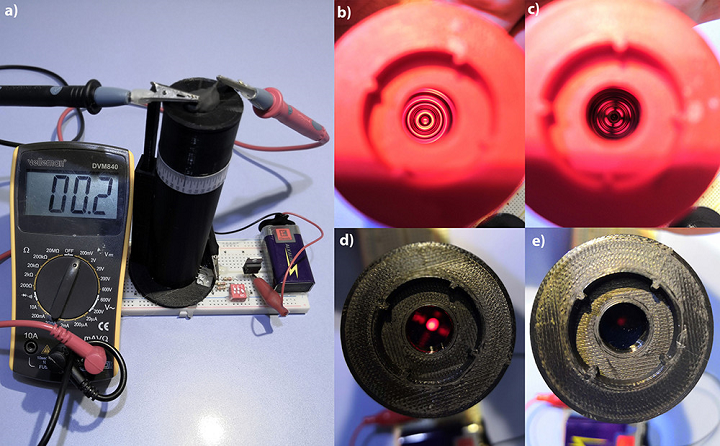
(a) Operating 3D printed cuvette polarimeter with photodiode detector at zero position (minimum signal); (b) operating 3D printed test tube polarimeter (maximum signal); (c) operating 3D printed test tube polarimeter (min signal); (d) operating the 3D printed cuvette polarimeter (max signal); (e) operating 3D printed cuvette polarimeter (min signal).
The researchers tested 50 high school chemistry students in Poland and 15 organic chemistry university students in the US on taking measurements with the 3D printed polarimeter. Working in groups of 2-3, they ran measurements with pure liquids first, and then aqueous solutions. It’s quick and easy to use – the students can change samples and adjust a cap rotation in less than a minute, though they must be told which way to rotate the tool for different substances as “the device gives the same readings in both directions (90° = −270°).”
“It is also advised to adjust the concentration of the sample solution and path length so that the readings are in the range of the provided rotation scale (from −180° to +180°). Using measured rotation and simple mathematical relations, students can calculate a substance’s specific rotation,” the researchers said.
The students used (R)-limonene, fructose, and sucrose, and ran initial measurements both visually and with the 3D printed polarimeter, which allowed them to take measurements with three colors thanks to its RBG diode. They made 4 to 6 measurements for a sample and after dilation for the aqueous solutions.
“The results were a starting point for a discussion on optical rotatory dispersion phenomena. Calculating the specific rotation of the substances was homework, verified by the teacher during subsequent classes,” the researchers stated.
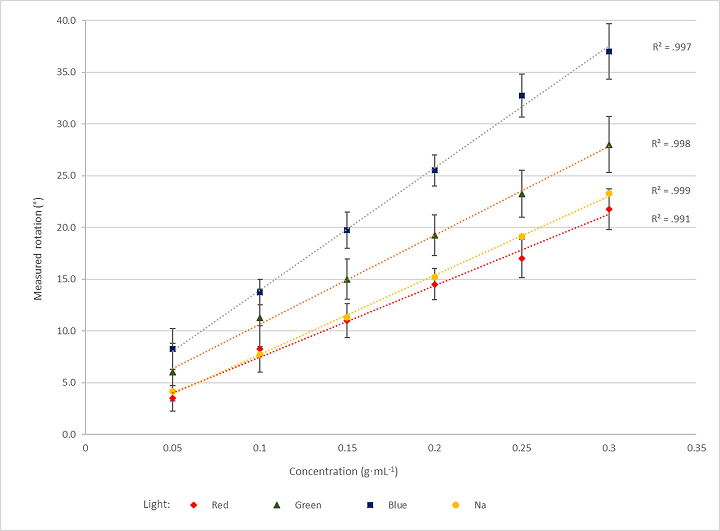
Measured rotation for aqueous solutions of sucrose in the concentration range of 0.05–0.35 g·mL, a series for red, green, blue light measured with a 3D printed polarimeter, and accompanied by results from commercial polarimeter with a sodium lamp 589 nm.
In another project, instructors prepared kits with all of the materials needed to assemble the polarimeter, including breadboards and the 3D printed body. 16 chemistry majors in Poland and four US undergrad students constructed the device, working in pairs, and none had previous experience using breadboards or building measuring devices. But they followed detailed instructions, with some help from teachers, and succeeded in building operational polarimeters in less than one hour.
Discuss this and other 3D printing topics at 3DPrintBoard.com or share your thoughts below.
The post Researchers Create Low-Cost 3D Printed Polarimeter for Use in Chemistry Classrooms appeared first on 3DPrint.com | The Voice of 3D Printing / Additive Manufacturing.


